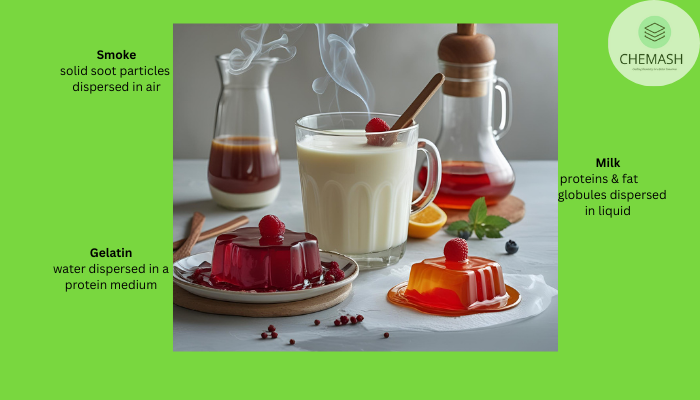Colloids: Definition, Types, Properties, and Applications
Colloids are heterogeneous mixtures where one substance (the dispersed phase) is distributed evenly throughout another substance (the dispersion medium). The particle size in a colloid typically ranges between 1 nm and 1000 nm, making them larger than molecules but small enough to remain suspended without settling.
Examples of Colloids in Daily Life
- Milk (emulsion)
- Fog (aerosol)
- Butter (gel)
- Smoke (solid aerosol)
Types of Colloids
Colloids can be classified based on the physical state of the dispersed phase and dispersion medium:

| Type | Dispersed Phase | Dispersion Medium | Example |
|---|---|---|---|
| Sol | Solid | Liquid | Paint |
| Gel | Liquid | Solid | Cheese |
| Aerosol | Solid/Liquid | Gas | Fog, Smoke |
| Emulsion | Liquid | Liquid | Milk |
Properties of Colloids
- Tyndall Effect: Scattering of light by colloidal particles.
- Brownian Movement: Random motion of particles due to collisions.
- Adsorption: Colloids can adsorb ions from their medium.
- Electrical Charge: Colloidal particles carry a charge preventing aggregation.
Applications of Colloids
- Medicine (e.g., colloidal gold)
- Food industry (ice cream, mayonnaise)
- Industrial (paints, rubber, cosmetics)
- Purification of water
MCQ Quiz: Test Your Knowledge on Colloids
1. The size range of colloidal particles is:
A) 1–1000 nm ✅
2. Milk is an example of:
B) Emulsion ✅
3. Tyndall effect is caused due to:
C) Scattering of light ✅
4. Which of the following is a solid sol?
D) Gemstones ✅
5. Brownian movement is caused by:
A) Collisions with molecules of dispersion medium ✅
True/False Questions
1. Colloids are always transparent.
❌ False — They are typically translucent or opaque.
2. Colloids can be separated by filtration.
❌ False — They require ultrafiltration.
3. The dispersion medium in fog is air.
✅ True
